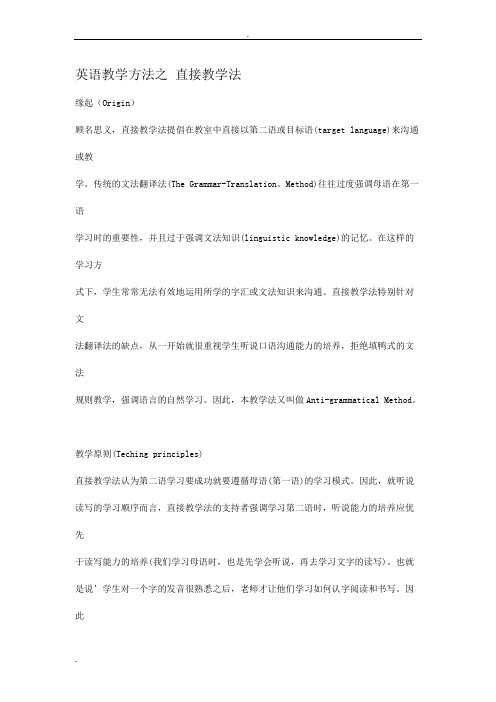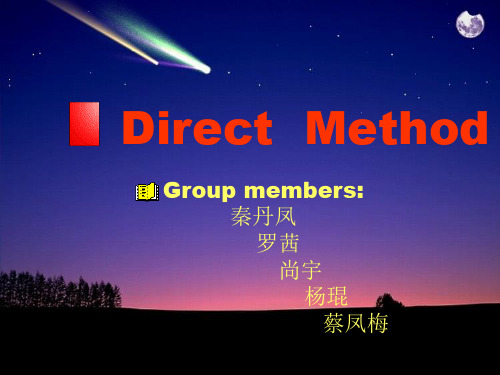自考外语教学法之直接法
- 格式:doc
- 大小:163.00 KB
- 文档页数:20

英语教学方法之直接教学法缘起(Origin)顾名思义,直接教学法提倡在教室中直接以第二语或目标语(target language)来沟通或教学。
传统的文法翻译法(The Grammar-Translation、Method)往往过度强调母语在第一语学习时的重要性,并且过于强调文法知识(linguistic knowledge)的记忆。
在这样的学习方式下,学生常常无法有效地运用所学的字汇或文法知识来沟通。
直接教学法特别针对文法翻译法的缺点,从一开始就很重视学生听说口语沟通能力的培养,拒绝填鸭式的文法规则教学,强调语言的自然学习。
因此,本教学法又叫做Anti-grammatical Method。
教学原则(Teching principles)直接教学法认为第二语学习要成功就要遵循母语(第一语)的学习模式。
因此,就听说读写的学习顺序而言,直接教学法的支持者强调学习第二语时,听说能力的培养应优先于读写能力的培养(我们学习母语时,也是先学会听说,再去学习文字的读写)。
也就是说’学生对一个字的发音很熟悉之后,老师才让他们学习如何认字阅读和书写。
因此对直接教学法来说,四种语言技巧的学习顺序应该是:听→说→读→写。
精确发音的养成在一开始就很重视,若同时强调四种技巧的练习’将会对学生的学习造成困扰。
这样的思考也表现在课堂活动的操作上,如听写活动(dictation)是直接教学法常用的教室活动之一。
老师会要求学生在“写”之前,先专心听一次内容;念第二次时再写下他们所听到的课文内容。
此外,为了让第二语学习环境更接近母语学习环境,直接教学法还对课堂教学提出了三点具体建议。
第一,课堂中禁用母语。
母语学习者因为没有其他语言的干扰’母语的学习才能如此成功。
因此,直接教学法的支持者认为第二语的学习也应将学生其他语言(母语)的千扰减到最低:老师不用母语来解释、翻译或分析。
若老师允许学生遇到沟通困难时就依赖母语,那就剥夺了学生学习以第二语沟通的机会。

外语教学直接法举例一、直接法在外语教学中的举例外语教学中的直接法可是超级有趣的呢!就比如说在教英语的时候吧。
(一)词汇教学1. 我们可以拿着一个苹果,然后指着它对学生说“apple”。
这种通过实实在在的物体来教授单词的方式,学生一下子就能把这个单词和这个具体的东西联系起来啦。
不像那种单纯死记硬背的方法,学生可能背了半天还是不知道这个单词到底是啥玩意儿。
就像我以前背单词的时候,如果没有这种直观的东西,就老是容易忘。
而且在课堂上,我们还可以把各种水果都拿出来,像香蕉“banana”、橙子“orange”之类的,让学生一边摸一边说,这样记忆就更深刻啦。
2. 再比如说教动物单词,我们可以学猫“cat”的时候,就学猫叫“喵呜”,然后做出猫的动作,学生们就会觉得特别好玩儿。
还可以让学生们自己模仿,他们就会特别积极地参与进来。
对于一些比较大的动物,像大象“elephant”,我们可以给他们看大象的图片或者视频,让他们看到大象长长的鼻子、大大的耳朵,这样就很容易记住这个单词啦。
(二)句子教学1. 在教句子的时候,比如“ I'm hungry.”我们可以假装捂着肚子,做出很饿的样子,然后说这个句子。
学生看到老师这样的表演,就很容易理解这个句子的意思啦。
然后可以让学生们自己也来表演,互相说这个句子。
这可比单纯地让他们读句子有意思多了。
2. 还有像“Open the door.”我们可以真的走到教室的门那里,然后做开门的动作,一边做一边说这个句子。
接着让学生来做这个动作并且说句子。
这样在实际的动作中学习句子,他们就不会觉得句子是那么枯燥难懂的东西啦。
(三)语法教学1. 拿一般现在时来说吧,我们可以描述每天都做的事情。
比如老师可以说“I get up at seven every day.”然后一边说一边做起床的动作。
然后让学生们也说自己每天做的事情,像“I have breakfast at eight.”这样通过自己的实际生活来理解语法,比单纯讲那些语法规则要容易得多。

几种外语教学方法比较(一)一、翻译法(TranslationMethod)翻译法,也有称它为语法翻译法,它的最简单的定义是:用母语教授外语的一种方法。
它的特点是:在外语教学过程中母语与所学外语经常并用。
例如:老师说“apple”,学生马上说出“苹果”。
2、主张讲授语法知识,重视理性,注意磨练学生的智慧,强调在教学中发展学生的智力。
3、主张通过阅读外语名著学习外语,进而培养学生阅读外语的能力。
翻译法所遵循的教学基础原则:1、语音、语法、词汇教学相结合。
2、阅读领先,着重培养阅读与翻译能力,兼顾听说训练。
3、以语法为主,在语法理论指导下读译课文。
4、依靠母语,把翻译既当成教学手段,又当作教学目的。
在课堂教学中,使用翻译法教学的教师,不必有流畅的外语口语,一般只要按照课文,逐词逐句地进行翻译讲解,用母语解释清楚所学语言的准确意思即可。
课堂教学过程比较好控制,选择对学生的测试方法也比较容易。
用这种方法训练学生的弱点是:外语口语表达能力弱,语音语调较差。
虽学了大量的语法规则,一旦用于实践,如写作,口头交谈,便会频频出现错误。
不难看出翻译法的缺点是:1、未能恰当地发挥母语在外语教学中的积极作用和过分强调语言知识的传授,忽视语言技能的培养,语音、语法、词汇与课文的阅读教学脱节。
2、过分强调用翻译法进行教学,容易养成学生在使用外语时依靠翻译的习惯,不利于培养学生用外语进行交际的能力。
3、强调死记硬背,教学方式单一,课堂教学气氛沉闷,不易引起学生的兴趣。
翻译法的优点是:1、在外语教学里利用文法,利用学生的理解力,以提高外语教学的效果。
2、重视阅读、翻译能力的培养,重视语法知识的传授以及对学生智慧的磨炼。
3、使用方便。
只要教师掌握了外语的基本知识,就可以拿着外语课本教外语。
不需要什么教具和设备。
4、在外语教学里创建了翻译的教学形式,对建立外语教学法体系做出了重大的贡献。
随着科学的进步,教学经验的不断丰富,翻译法吸取了其他教学法的一些优点,不断修正和完善自己,在以阅读为主的情况下,兼顾听说和写作能力的培养。


英语教学法讲座之一--直接法英语教学法讲座之一--直接法直接法(The Direct Method)产生于19世纪90年代,是通过运用外语本身进行教学的方法,也叫自然法或口语法,代表人物是德国外语教学法专家贝立兹(M.D.Berlitz)和英国语言学家帕默(H.E.Palmer)。
贝立兹主张力求在外语教学中创造与儿童习得母语的自然环境相仿的环境,并采用与儿童习得母语的自然方法相一致的方法。
帕默认为语言是一种习惯,学习一种语言就是培养一种新的习惯,习惯的养成是靠反复使用形成的。
自然法是对儿童学习母语的自然过程的模仿,主张把外语和它所表达的事物直接联系起来,在教学中只用外语,排斥母语,通过各种直观手段直接学习,直接理解,直接运用。
从20世纪70年代末到80年代初期间,美国加州大学爱尔伐因分校的特雷尔(TrayD.Terrel)和美国南加州大学应用语言学家克拉申(StephenD.Krashen)共同提出了新的自然法。
他们认为语言习得是无意识地掌握语言,是在自然交际情景中培养运用语言的能力,并在无意识中习得语法的一般规则。
语言学习是有意识地学习语言规则和形式。
克拉申和特雷尔认为,在学习英语的过程中,用习得的方式比学习的方式效果好得多。
因此,课堂环境应该尽量接近学生的实际生活。
教师应利用学生过去所学的知识,设计与讲英语国家的文化相近、便于学习理解的教学活动。
在介绍新词汇、引进新知识的时候,教师要尽可能结合周围实际环境。
克拉申和特雷尔进而说明,语言发展是有阶段性的,应该由简而繁、逐渐提高。
克拉申把实施自然教学法的过程分成四个阶段。
第一阶段,教师在课堂上和学生自然地谈话,使用基本的词汇和句型,并且突出、重复重点词汇,教师通过身体动作和视觉提示,如图片、实物等,帮助学生理解。
这时只要求学生能够听懂和执行简短的英语指令,作出非语言性的反应。
许多学生在开口之前要经过一个“沉默”的阶段,这是正常的。
在这个时候,教师要有耐心,不要过多催逼。

几种外语教学方法比较(一)摘要:外语教学法是研究、教授和学习外语规律的科学。
本文旨在选取不同历史发展阶段影响较大的四种外语教学方法做一比较,对其做出评价,辨析利与弊,以便教师在教学中能够扬长避短,提高自己的教学水平。
关键词:翻译法(TranslationMethod),直接法(DirectMethod),听说法(Audio-lingualap-proach),交际法(CommunicativeApproach)为了使我们的教师能自觉主动地驾驭各种教学法,提高教学质量,本文旨在向同行们介绍一下各种教学法产生的历史背景,理论基础,基本原则及其评价,目的在于提高对教学法理论的的认识和加强对教学实践的指导。
一、翻译法(TranslationMethod)翻译法成为一种科学的教学法体系是近一百年的事。
中世纪希腊语和拉丁语在欧洲盛行,拉丁语是当时欧洲文化教育、著书立说的国际语言及教会和官方语言,当时的教学方法就是翻译法。
到十八、十九世纪,英语、法语兴起,学校开始开设英语、法语等现代语言课程。
由于找不到新的教学方法,语言教学就自然地沿用教授希腊、拉丁语等古典语的翻译法。
翻译法,也有称它为语法翻译法,它的最简单的定义是:用母语教授外语的一种方法。
它的特点是:在外语教学过程中母语与所学外语经常并用。
例如:老师说“apple”,学生马上说出“苹果”。
翻译法是外语教学的原始方法,它是历史的产物,它的产生是外语教学发展的必然。
它培养了大批符合当时社会需要掌握阅读外语能力的人材。
它在外语教学法方面的主要成就是:1、创建了外语教学中利用母语的理论,在教学实践中把翻译既当成教学目的,又当成教学手段。
2、主张讲授语法知识,重视理性,注意磨练学生的智慧,强调在教学中发展学生的智力。
3、主张通过阅读外语名著学习外语,进而培养学生阅读外语的能力。
翻译法所遵循的教学基础原则:1、语音、语法、词汇教学相结合。
2、阅读领先,着重培养阅读与翻译能力,兼顾听说训练。
According to the Direct Method, every language has _______ structure.A. similarB. its ownC. co-relatedD. the sameThe Direct Method _______ the similarities between the first language acquisition and second language learning.A. is againstB. overemphasizesC. draws onD. pays no attention toAdvocates of the Direct Method consider students' mother tongue as _______ system in learning the second language.A. an interferingB. a helpingC. an integratingD. a similarThe relationship between the grammatical forms and their functions is nota _one- to- one______ correspondence.Reinforcement which increases the likelihood of a response is known as _positive______ reinforcement.Why is the first language forbidden in the Direct Method classrooms?______ can be introduced as a means of consolidation and evaluation in the Direct Method.A. ReadingB. ListeningC. SpeakingD. WritingIn the Direct Method, the target language is used _exclusively____ in the language classroom as a means of instruction and communication.Although the teaching of all four language skills is advocated by most Direct Methodologists, _oral_____ communication skills are regarded as basic.Classroom procedures in the Direct Method can be roughly divided into three phases. What are they?In the Direct Method only _everyday_______ vocabulary and sentences are taught.The __direct______ Method advocated the priority of oral skills for the first time in the language teaching field.The first Berlitz School was established in()A. 1778B. 1828C. 1878D. 1928In the Direct Method,()communicative skills are regarded as basic.A. visualB. non-verbalC. writtenD. oralThe Direct Method was developed in the()century.A. late 18thB. early19thC. late 19thD. early 20thNew teaching points are introduced()in the Direct Method classrooms.A. orallyB. in the written formC. in discourse contextsD. in socical contextsA: the main features of the direct method: B: the advantage ordisadvantageassociated with the feature①The students are encouraged to learn to a. Regarding listening andspeaking as thebasis ofthink in the target language. reading and writing isstrategic infostering thefour skills.②The target language is used exclusively b. Thinking in the targetlanguage isnecessary inin the language classroom. efficient realcommunication.③Grammar is learned inductively. c. Learners lack a necessaryknowledge of the targetlanguage grammar.④Oral communication skills are regarded d. It is difficult to teach the meaning of abstractas basic. concepts.⑤The basic unit in a language is the e. Using full sentences as teaching units make foreignsentence. language learning more natural and efficient.What are the most frequently used techniques of consolidating in the Direct Method?WritingAll of the following principles reflect the influence of structural linguistics and behaviourist psychology in language teaching except that .A. language is speech, not writingB. a language is what its native speakers say, not what someone thinks they ought to sayC. languages are differentD. competence comes before performanceAccording to the advocates of the Direct Method, the verbal expression of an event isa word, but a .Towards the end of the 19th century, the language teaching innovation turned into thereform Movement.Grammar is learned inductively by listening and speaking activities in the Direct Method, that is, by encouraging learners to induce rules by active use of languageAccording to the psychological principles of the German scholar F. Franke, a direct association between forms and meaning in the target language should be established.What language skills are emphasized by the Direct Method? Why?Do you think the Direct Method can be used in the second language classrooms today? Why or why not?Direct association of language with objects and persons of the immediate environment is emphasized in the _____________________.The Direct Method was developed in the 19th century as a reaction against _grammer-traslation method____.A. the Oral ApproachB. the Natural MethodC. the Grammar-Translation MethodD. the AudiolingualMethodStudents’ mistakes are ________ corrected in the classrooms of the Direct Method.()A.neverB.immediatelyC.seldomD.carelesslyIn the Direct Method ______ are used as teaching units.()A.wordsB.phrasesC.sentencesD.discoursesOne of the important ways of correcting language mistakes in the Direct Method is _______.()A.discussionB.explanationC.demonstrationD.self-correctionIn the Direct Method, direct means takes the place of _________ of the Grammar-Translation Method.The target language is used ___exclusively __________ in the Direct Method classroom as a means of instruction and communication.In the Direct Method, the most frequently used techniques of consolidating what has been presented and practiced are ______________, purposeful tasks and graded composition.In the Direct Method, ______ is learned inductively through listening and speaking activities.A. grammarB. vocabularyC. writingD. sentenceWhen was the Direct Method developed as a reaction against the Grammar-Translation Method?A. In the late 19th century.B. In the early 20th century.C. In the mid-19th century.D. In the early 19th century.F. Gouin’s linguistic and psychological theories based on his observations of children’s use of language were directly applied to the practice of the _direct_____ Method.The reason for the exclusive use of the foreign language in the Direct Method is to enable the students to think in the target language, so that they can use it to express themselves __directly____ without referring to their mother tongue.What is the learning theory of the Direct Method as summarized by Comenius?The Direct Method emerged as a result of _______ in the 19th century.A. classroom instructionB. mass productionC. communicative needsD. language teaching innovationsWhich of the following is forbidden in a Direct Method classroom?A. Using gestures.B. Sketch drawing.C. First language.D. Writing.The Direct Method believes in the natural process of language learning and in the __inductively_______ teaching of grammar.F. Gouin developed an approach to teaching a foreign language on the basis of his observations of child first language learning. In his method new language items were organized and presented in “series” which included sequences of sentences related to __action______ in an event.What are the teaching techniques used in the Direct Method?According to Gouin, ______ expression is intimately linked with thought about real events.A. linguisticB. verbalC. facialD. naturalWhat can be introduced as a means of consolidation and evaluation in the Direct Method?A. Fill-in-the-blank.B. Dictation.C. Writing.D. Reading.The Direct Method got its name from the assumption that _association_____ are to be connected directly with the target language, without going through the process of translating into the student’s native language.Although the teaching of all four language skills is advocated by most Direct Methodologists, __oral____ communication skills are regarded as basic.In the Direct Method, the most frequently used techniques of consolidating what has been presented and practiced are_dictation_____, purposeful tasks and graded composition.What advantages can be found in the Direct Method?_____ ideas on education justified the views on language teaching with the Direct Method.A. Hermann Paul’sB. J.A. Comenius’C. F. Gouin’sD. W.M. Wundt’sThe leaning of a foreign language was viewed by the Direct Methodologists as analogous to the language ____, and the learning processes involved were often interpreted in terms of an associationist psychology.The syllabus used in the Direct Method is arranged semantically according to _situation___ or topics.What are the objectives of the Direct Method?Which of the following is forbidden in a Direct Methodclassroom?A. Using gestures.B. Sketch drawing.C. First language.D. Writing.The syllabus used in the Direct Method is arranged semantically according to _______.A. situations or topicsB. textbooks or materialsC. ideas or conceptsD. students or learnersdirect_____ association of language with objects and persons of the immediate environment is emphasized in the Direct Method.The Direct Method believes in the natural process of language learning and in the_inductive______ teaching of grammar.In the Direct Method students are encouraged to learn to __think_____ in the target language.What are the classroom procedures used in the Direct Method?Please make a comment on the advantages and disadvantages of the Grammar-Translation Method._____ was developed in the late 19th century as a reaction against the Grammar-Translation Method.A. The Oral ApproachB. The Audiolingual MethodC. The Direct MethodD. The Cognitive ApproachWhat can be introduced as a means of consolidation and evaluation in the Direct Method?A. Fill-in-the-blank.B. Dictation.C. WritingD. Reading.____ ideas on education justified the views on language teaching with the Direct Method.A. Hermatnn Paul'sB.J.A. Comenius’The syllabus used in the_direct___ Method is arranged semantically according to situations or topics.Although the teaching of all four language skills is advocated by most Direct Methodologists, _oral____ communication skills are regarded as basic.What advantages can be found in the Direct Method?The structural linguists believed that the primary medium of language is ______.A. written expressionB. sign languageC. oral speechD. body poseThe neogrammarians, represented by______, formed the main linguistic basis of the Direct Method.A. W. M. WundtB. J.A. ComeniusC. F.GouinD. Hermann PaulIn both the Direct Method and the Oral Approach, grammar is taught ______.A. deductivelyB. inductivelyC. positivelyD. negativelyThe Direct Method emerged as a result of ______ in the 19th century.A. classroom instructionB. mass productionC. communicative needsD. language teaching innovationsF.Gouin’s linguistic and psychological theories based on his observations of children’s use of language were directly applied to the practice of the _direct_____ Method.The Direct Method got its name from the assumption that ______ are to be connected directly with the target language, without going through theprocess of translating into the students' native language.The learning of a foreign language was viewed by the Direct Methodologists as analogous to the language _acquisition_____, and the learning processes involved were often interpreted in terms of an associationist psychology.What is the learning theory of the Direct Method according to Comenius?The best-known reformer in the mid-19th century is ______,who developed an approach to teaching a foreign language on the basis of his observations of child first language learning.A. M. D. BerlitzB. W. M. WundtC. J. A. ComeniusD. F. GouinIn the Direct Method,teachers encourage learners to ______ rules of grammar through active use of the target language in the classroom.A. applyB. analyzeC. induceD. paraphraseThe Direct Method got its name from the assumption that ______ are to be connected directly with the target language,without going through the process of translating into the students’native language.The neogrammarians,represented by Hermann Paul,formed the main linguistic basis of the _direct_____ Method.What is the learning theory of the Direct Method according to J. A. Comenius?Discuss in your own words the advantages of the Direct Method.In the Direct Method, teachers encourage learners to _______ rules of grammar through active use of the target language in the classroom.A. applyB. analyzeC. induceD. paraphrase_________can be introduced as a means of consolidation and evaluation in the Direct Method.A. ReadingB. ListeningC. SpeakingD. WritingIn the Direct Method, the target language is used _directly________in the language classroom as a means of instruction and communication.The Direct Method advocates the importance of oral language and believes that language should be learned through direct _association_____ of form and meaning.The Direct Method believes in the _direct______ process of language learning and in the inductive teaching of grammar.What advantages can be found in the Direct Method?。